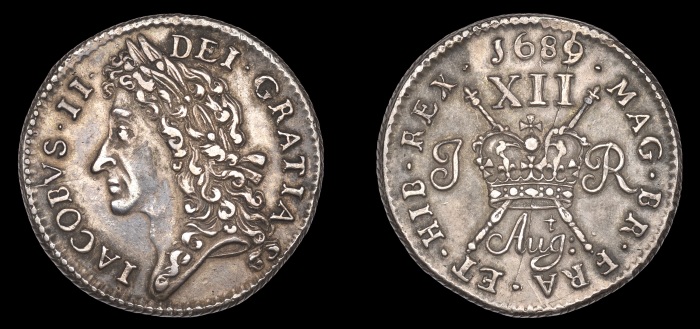The production of James II’s gunmoney was ramped up in July of 1689 to include shillings and halfcrowns, as well as the sixpences first introduced in June. In August, the two coin presses in Capel Street continued production 24 hours a day, with mint workers employed in two 12-hour shifts per day.
Production rates at this pace and volume inevitably causes damage to dies and they have to be replaced. The gunmoney for August is found in a number of different varieties, e.g.

Gunmoney coinage, Sixpence, 1689 Aug

James II, Gunmoney Shilling, large size, 1689 Aug + full stop. Reverse XII over crown. Usual surface porosity

James II, Gunmoney Shilling, large size, 1689 Augt, with ‘t’ above (to the right of ‘g’) + full stop. Laureate head left. Reverse XII over crown

James II, Gunmoney Shilling, large size, 1689 Augt, with ‘t’ above (to the right of ‘g’) + full stop. This die variation has the ‘t’ in Augt much closer to the sceptre. Laureate head left.

James II, Gunmoney Shilling, large size, 1689 Aug, with large ‘t’ above (between ‘u’ and ‘g’) + full colon

James II, Gunmoney Proof Shilling in Silver, large size, 1689 Aug, with small ‘t’ above (between ‘u’ and ‘g’) + full colon

James II, Gunmoney Halfcrown, Large size, 1689 Aug (damaged). Laureate head left. Reverse XXX over crown
Timeline: August 1689
13 August
Marshal Frederick Schomberg, 1st Duke of Schomberg (at that time a Brandenburg general “on loan” to William) landed at Ballyholme Bay, near Groomsport, Co Down with 10,000 men to defend the Williamite cause in Ireland.
- Schomberg was now 82 years old – a Protestant (Huguenot) that had been driven out of France, a country he had risen to be a Marshal in the army, by the revocation of the Edict of Nantes, after which he took service under William of Orange, now King of England and enemy of the absolute monarch of France – Louis (the Sun King).
- He brought over an army composed of many nationalities
- They also comprised many different variations of Protestantism
- And some of his troops were Catholic
- This war was not a ‘sectarian’ war (Catholic v Protestant)
- It was about Absolute Monarchy v Constitutional Monarchy
- The English Parliament feared a return to ‘absolutism’
- The Pope feared that Catholic kings would consider themselves above him
- For this reason, he backed William of Orange against the Catholic King of France and his ‘political pawn’ James II
14 August
- The Jacobite army marched from Drogheda to nearby Ardee, in Co Louth
15 August
- The Jacobite army begins to encamp at Ardee – building huts and fortifying their perimeter. Alarms are sounded and the army is tested for its readiness to fight
16 August
- King James II inspects his troops at Ardee
- Scouts and patrols report no sight of the enemy force under Schomberg
17 August
- The Jacobite army de-camps Ardee, marches to nearby Affane and camps there
- Scouts and patrols report no sight of the enemy force under Schomberg
22 August
- About fifty ships anchor off Carrickfergus and bombard the castle and town.
27 August
- The 2,500 Jacobite soldiers in Carrickfergus Castle surrender
- After capturing Carrickfergus, Schomberg’s army march unopposed to Dundalk.
- James’s viceroy Tyrconnell, commanding the main Jacobite army, blocked Schomberg’s passage southwards but did not give battle.
- The two armies would remain encamped opposite each other in cold, wet weather for several weeks before they withdrew to winter quarters.
- Set down in camp in Dundalk, the bad food, the moistness of the climate, and the lazy carelessness of the English, who would not build for themselves the necessary shelters, wrought havoc with Schomberg’s fine army.
- It was fast melting away with disease, lice, and scurvy
- The ships and the great hospital in Belfast were crowded with sick men, and between November and the following May over 3,760 were buried from this hospital alone
- Encamped in similarly poor conditions at Ardee, the Jacobite army began to break up for the winter – despite apparent advantages, James failed to act.


